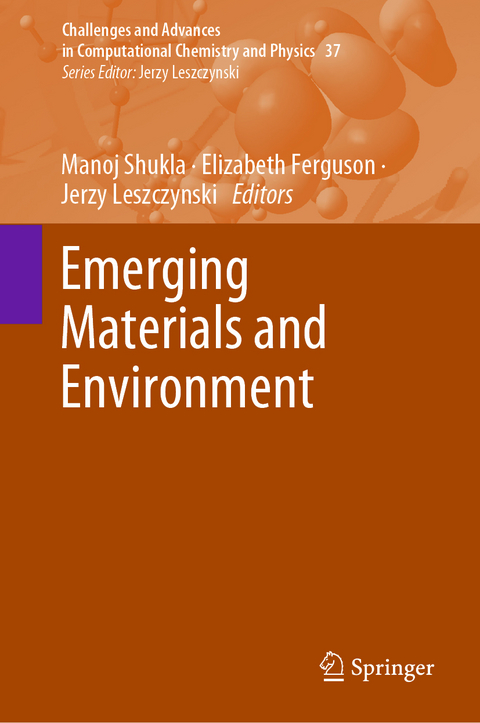
Emerging Materials and Environment
Springer International Publishing (Verlag)
978-3-031-39469-0 (ISBN)
lt;b>Dr. Manoj K. Shukla is a Senior Research Physical Scientist and Computational Chemistry Team Leader at the Environmental Laboratory, US Army Engineer Research and Development Center, Vicksburg, Mississippi, USA. His research interests span a broad range of topics focusing on computational chemistry modeling and simulation of complex environments, fate, effects, and transport of environmental contaminants, multifunctional and nanocomposite materials, and soil modeling. Currently, he is developing technologies for the degradation, destruction, removal, isolation, and sensing of PFAS compounds from the environment. He is also developing technologies on the awareness of chemical hazards in the contested environment. He has published over 115 peer-reviewed research papers, 15 book chapters, has edited/coedited 10 books, and has presented at various conferences and symposia. He has been cited over 3000 times and carries an h-index of 31 and i10-index of 74 (Google Scholar).
Dr. Elizabeth Ferguson serves as an Army Senior Science Technical Manager and is the Lead Technical Director (TD) for the Installations and Operational Environments (IOE) Research and Development Area and Technical Director of the Military Materials in the Environment (MME) program at the U.S. Army Engineer Research and Development Center (ERDC), Vicksburg, Mississippi. As Lead IOE TD, Elizabeth is responsible for programmatic direction of the research areas of adaptive and resilient infrastructure (the built environment) as well as the natural environment in environmental security and resiliency, environmental intelligence and understanding and managing military materials in the environment. Dr. Ferguson holds bachelor's degrees in chemistry and psychology (1991), master's degree in radio-analytical chemistry (1994), and Ph.D. (1998) in fish physiology and aquatic toxicology from the University of Kentucky. She has authored several peer-reviewed publications and book chapters and has presented at numerous conferences and symposia.
Dr. Jerzy Leszczynski is a Professor of Chemistry and a President's Distinguished Fellow at Jackson State University, Jackson, Mississippi, USA. His research activities cover a broad range of projects including studies of nature of chemical bonds, theoretical predictions of molecular potential energy surfaces, structures of weakly bonded complexes, properties of DNA fragments, interactions of explosives with soil, decomposition of nerve agents on metal oxides and clays, properties, and toxicity of nanomaterials. He has published over 1000 referred papers in leading journals and over 70 book chapters. He has edited and co-edited more than 50 books and has advised 30 students who already received their Ph.D. degrees. He has been cited over 40,000 times and carries an H-index of 96 (Google Scholar). His international awards include: a Guest Professorship, Chinese Academy of Sciences, Shanghai, China 2002; an Honorary Doctorates, Dnipropetrovsk National University, Ukraine 2003 and, Wroclaw University of Technology, Poland 2016, Outstanding Mississippi Chemist, ACS Mississippi Section, 2004; the Maria Sklodowska-Curie's Medal (Medal for prominent chemists working permanently abroad) Polish Chemical Society, 2007. He has been elected for: European Academy of Sciences 2002; International Academy of Engineering, 2003; Ukrainian Ecological Academy of Sciences, 2003 and European Academy of Sciences, Arts and Humanities, 2004. In 2009 he received the USA Presidential Award for Excellence in Science, Mathematics and Engineering Mentoring.
Emerging Materials and Environment: A Brief Introduction.- A Generalized Force-Modified Potential Energy Surface (G-FMPES) for Mechanochemical Simulations.- Chemometric Modeling of Emerging Materials for the Removal of Environmental Pollutants.- Ionic Liquids and Halloysite Nanotubes: Emerging Environmental chemicals of concern.- New frontiers for heterostructured nanocomposites with interfacial functionalities synthesized via laser ablation synthesis in solution (LASiS).- Recent mechanistic insights into some enzyme mimetic functions of ceria.- Emerging 2D Materials Based Nanoarchitecture for Water Purification.- Emergent Materials and Processes for Efficient Environmental Per- and Polyfluoroalkyl Substances Containment.- Life Cycle Considerations for Per- and Polyfluoroalkyl Substances (PFASs) and the Evolution of Society's Perspective on Their Usage
| Erscheinungsdatum | 20.10.2023 |
|---|---|
| Reihe/Serie | Challenges and Advances in Computational Chemistry and Physics |
| Zusatzinfo | XI, 324 p. 84 illus., 73 illus. in color. |
| Verlagsort | Cham |
| Sprache | englisch |
| Maße | 155 x 235 mm |
| Gewicht | 661 g |
| Themenwelt | Naturwissenschaften ► Chemie ► Physikalische Chemie |
| Schlagworte | Additive Manufacturing • Advanced materials • Computational Materials Modeling • Dredged materials environmental impact • emerging materials • Environmental Contaminants • Environmental hazards • Environmental impact of materials • Environmental remediation • Environmental Sensing • Fate and Transport • innovative materials • Life-Cycle Assessment • Materials and Environment • Materials development • Materials for environmental remediation • multifunctional materials • multiscale materials modeling • Novel Materials • QSAR/QSPR |
| ISBN-10 | 3-031-39469-0 / 3031394690 |
| ISBN-13 | 978-3-031-39469-0 / 9783031394690 |
| Zustand | Neuware |
| Informationen gemäß Produktsicherheitsverordnung (GPSR) | |
| Haben Sie eine Frage zum Produkt? |
aus dem Bereich


